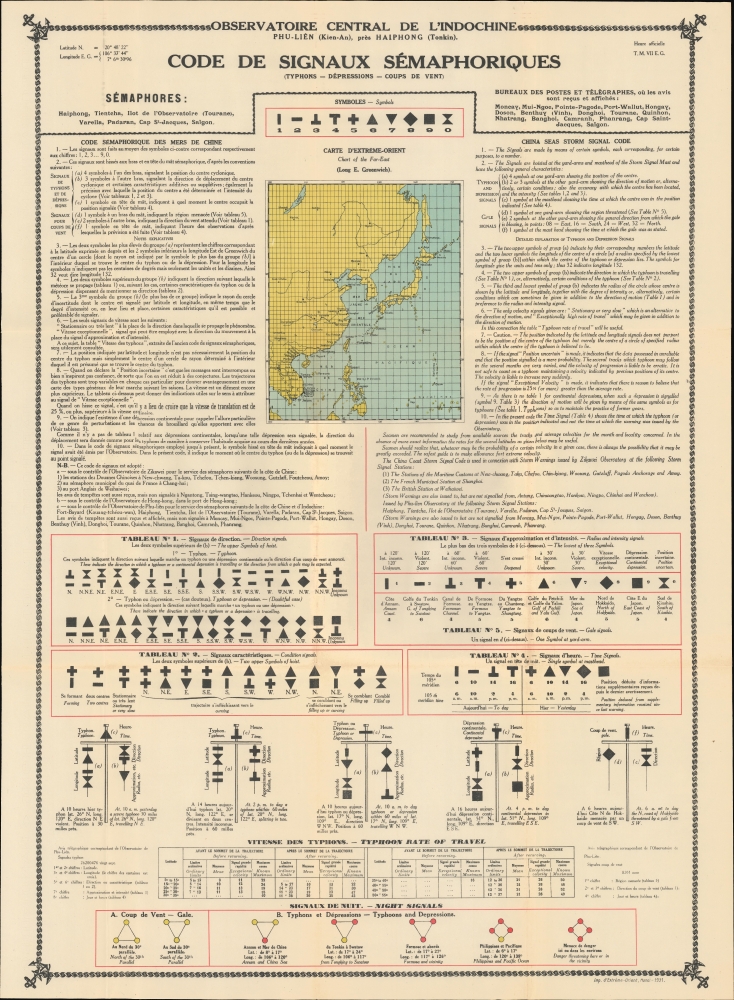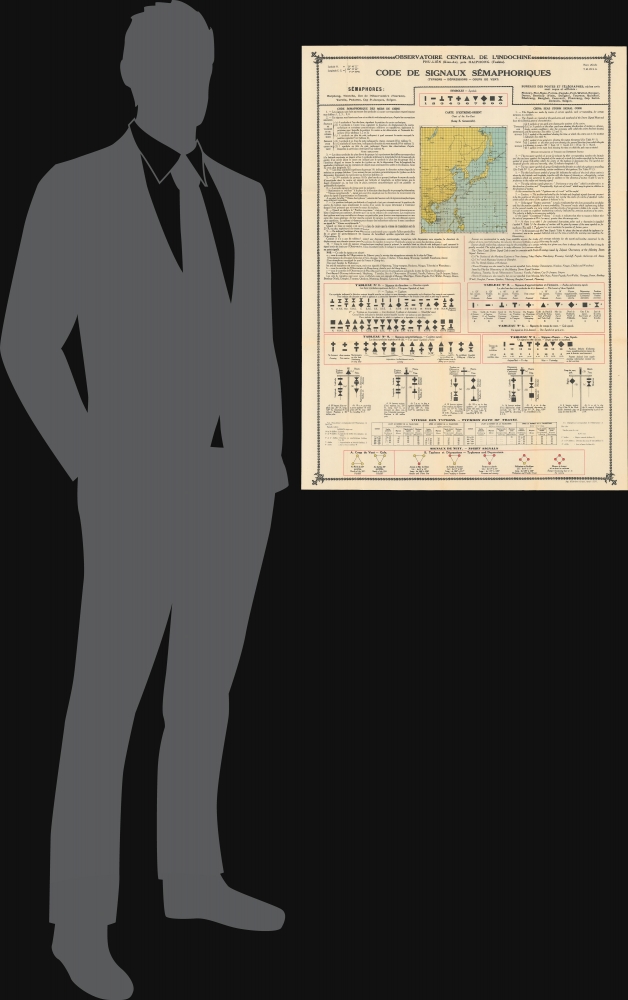1931 Observatoire Central de l'Indochine Map of the China Sea to Track Typhoons
Semaphoriques-indochina-1931
Title
1931 (undated) 30 x 22 in (76.2 x 55.88 cm)
Description
The Semaphore Telegraph
The semaphore is an optical telegraph invented by the French engineer Claude Chappe (1763 - 1805) during the Napoleonic Era (1799 - 1815). It consisted of a network of line-of-sight towers with mechanized lighting systems that could communicate complex data through pre-determined light and color patterns. Semaphores fell out of fashion in Europe by the mid-19th century, when electric telegraph lines were broadly implemented. However, in distant colonies, where wired telegraph systems were slow to emerge or difficult to manage, or in instances where communication with off-shore ships and light stations was essential, they remained in use until the early 20th century. The semaphore model was also adopted for aeronautical and maritime use.The introduction of a semaphore system at Phu Liên was an innovative approach to resolving communication issues between the central observatory and far-flung weather stations. While French Indochina had a sophisticated wired telegraph system, it did not extend to remote monitoring stations that regularly reported storm data to Phu Liên. Instead, the observatory resorted to the semaphore system of a century earlier to quickly and effectively transmit critical in-the-moment typhoon data. At Phu Liên, the data was compiled before wired telegraphs communicated storm warnings throughout French Indochina and to neighboring countries.
Above and below the map, the adapted and revised 'semaphore code' (code semaphorique) is explained. Bullet points detail how the code can communicate information concerning typhoons. Data that could be transmitted includes wind direction, the relative position of the typhoon, storm speed (even if it's an estimate), and more. Another table provides notes on interpreting the light signals at night.
A Closer Look
The map is intended to track and transmit typhoon data by a novel adaptation of the semaphore optical telegraph system. Using this map, a semaphore operator could communicate storm type, directions, wind speeds, longitude, and latitude. Centered roughly on Korea, coverage embraces all of East Asia, from Lake Bakail to Borneo, and from the Gulf of Siam to Hokkaido, incorporating most of China, French Indochina (Vietnam / Cambodia), the Philippines, Korea, Japan, and the eastern parts of Russia. Major cities and loose political boundaries are identified, and the whole is set on a longitude and latitude grid graduated by degree. Instructions on using the 'Semaphore Code' appear in both French and English to the left, right, and below the map. Numbered guides and diagrams detail how the code can communicate information. Data that could be transmitted includes wind direction, the relative position of the typhoon, storm speed (even if it's an estimate), and more.The Observatoire Central de l'Indochine
The Observatoire de l'Indochine, also known as the Observatory at Phu Liên, was established in 1902 by the French colonial administration to study weather in Indochina. Situated just south of Haiphong, the observatory tracked and disseminated storm information throughout French Indochina. It remained active until World War II (1939 - 1945), providing advance warning of some 400 typhoons, many of which made landfall. Today Phu Liên is a popular tourist destination known as the Tonkin or Haiphong Observatory.Publication History and Census
This map was printed in Hanoi in 1931 by the Imp. d’Extrême Orient for the Observatoire Central de l'Indochine. We have seen and handled an earlier variant on this chart, c. 1910 (TyphoonTracking-indochina-1910). The is one of only two known surviving examples, both of which are in private hands.Cartographer
Jean-François-Henri Schneider (December 1, 1851 - 1929/1930) was a French printer, publisher, and photographer active in French Indochina. The son of a French-German mason, Schneider fought as a volunteer during the 1870 Siege of Paris. He arrived in Saigon in 1882 after being recruited to work for the colonial government's printing office. The following year (1883) he was sent to Hanoi to create the Protectorate's printing house and he served as its first director. He resigned in 1885 and that year opened the very successful Imprimerie d'Extrême-Orient with his brother Ernest Hippolyte Schneider, the first private commercial printing house in Tonkin. They published from 1885 to about 1940 - surviving Schneider himself. In 1886, he bought the printing facility operated by the Protectorate Printing House and renamed the examined operation the Imprimerie Typographique de F.H. Schneider. In so doing, he also secured the contract to print all government papers, previously the pave of the Protectorate Printing House. Schneider established his own paper factory in 1891. He was also a passionate student of Vietnamese and formed great working relationships with local Vietnamese officials. He also edited dictionaries and other manuals in Vietnamese. He received the Legion of Honor in 1903. Schneider served as the director and editor if the Journal officiel de l'Indochine, founded the Revue indochinoise, and served as the director of L'Avenir du Tonkin. More by this mapmaker...




